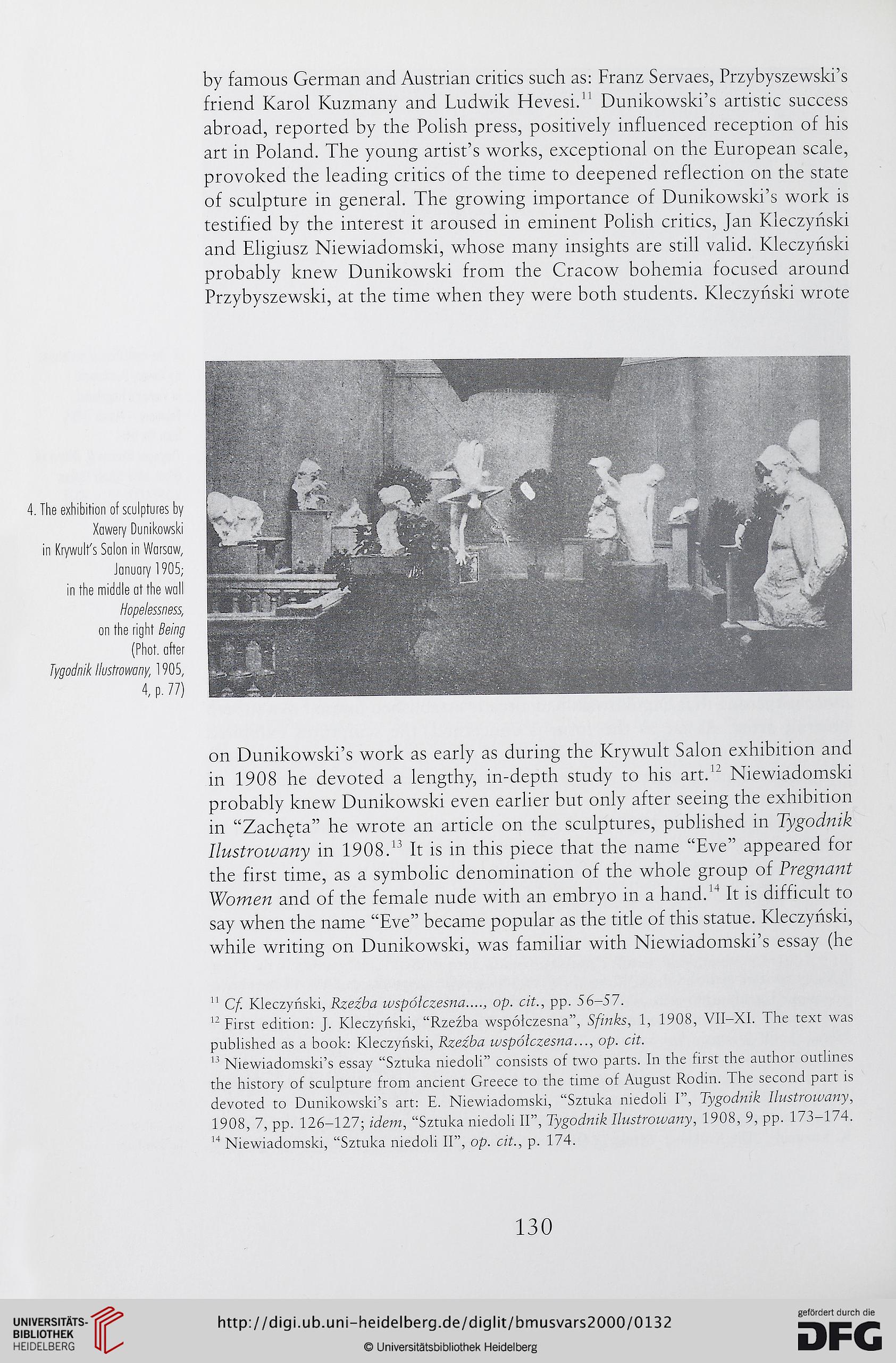by famous German and Austrian cridcs such as: Franz Servaes, Przybyszewskie
friend Karol Kuzmany and Ludwik Hevesi." Dunikowskie artistic success
abroad, reported by the Polish press, positively influenced reception of his
art in Poland. The young artiste works, exceptional on the European scalę,
provoked the leading critics of the time to deepened reflection on the State
of sculpture in generał. The growing importance of Dunikowskie work is
testified by the interest it aroused in eminent Polish critics, Jan Kleczyński
and Eligiusz Niewiadomski, whose many insights are still valid. Kleczyński
probably knew Dunikowski from the Cracow bohemia focused around
Przybyszewski, at the time when they were both students. Kleczyński wrote
4. The exhibition of sculptures by
Xawery Dunikowski
in Krywult's Salon in Warsaw,
January 1905;
in the middle atthe wali
Hopelessness,
on the righf Being
(Phot. after
Tygodnik Ilustrowany, 1905,
4, p. 77)
on Dunikowskie work as early as during the Krywult Salon exhibition and
in 1908 he devoted a lengthy, in-depth study to his art.11 12 * Niewiadomski
probably knew Dunikowski even earlier but only after seeing the exhibition
in “Zachęta” he wrote an article on the sculptures, published in Tygodnik
Ilustrowany in 1908.11 It is in this piece that the name “Eve” appeared for
the first time, as a symbolic denomination of the whole group of Pregnant
Women and of the female nudę with an embryo in a hand.14 It is difficult to
say when the name “Eve” became popular as the title of this statuę. Kleczyński,
while writing on Dunikowski, was familiar with Niewiadomskie essay (he
11 Cf. Kleczyński, Rzeźba współczesna...., op. cit., pp. 56-57.
12 First edition: J. Kleczyński, “Rzeźba współczesna”, Sfinks, 1, 1908, VII-XI. The text was
published as a book: Kleczyński, Rzeźba współczesna..., op. cit.
Niewiadomskie essay “Sztuka niedoli” consists of two parts. In the first the author outlines
the history of sculpture from ancient Greece to the time of August Rodin. The second part is
devoted to Dunikowskie art: E. Niewiadomski, “Sztuka niedoli I”, Tygodnik Ilustrowany,
1908, 7, pp. 126-127; idem, “Sztuka niedoli II”, Tygodnik Ilustrowany, 1908, 9, pp. 173-174.
14 Niewiadomski, “Sztuka niedoli II”, op. cit., p. 174.
130
friend Karol Kuzmany and Ludwik Hevesi." Dunikowskie artistic success
abroad, reported by the Polish press, positively influenced reception of his
art in Poland. The young artiste works, exceptional on the European scalę,
provoked the leading critics of the time to deepened reflection on the State
of sculpture in generał. The growing importance of Dunikowskie work is
testified by the interest it aroused in eminent Polish critics, Jan Kleczyński
and Eligiusz Niewiadomski, whose many insights are still valid. Kleczyński
probably knew Dunikowski from the Cracow bohemia focused around
Przybyszewski, at the time when they were both students. Kleczyński wrote
4. The exhibition of sculptures by
Xawery Dunikowski
in Krywult's Salon in Warsaw,
January 1905;
in the middle atthe wali
Hopelessness,
on the righf Being
(Phot. after
Tygodnik Ilustrowany, 1905,
4, p. 77)
on Dunikowskie work as early as during the Krywult Salon exhibition and
in 1908 he devoted a lengthy, in-depth study to his art.11 12 * Niewiadomski
probably knew Dunikowski even earlier but only after seeing the exhibition
in “Zachęta” he wrote an article on the sculptures, published in Tygodnik
Ilustrowany in 1908.11 It is in this piece that the name “Eve” appeared for
the first time, as a symbolic denomination of the whole group of Pregnant
Women and of the female nudę with an embryo in a hand.14 It is difficult to
say when the name “Eve” became popular as the title of this statuę. Kleczyński,
while writing on Dunikowski, was familiar with Niewiadomskie essay (he
11 Cf. Kleczyński, Rzeźba współczesna...., op. cit., pp. 56-57.
12 First edition: J. Kleczyński, “Rzeźba współczesna”, Sfinks, 1, 1908, VII-XI. The text was
published as a book: Kleczyński, Rzeźba współczesna..., op. cit.
Niewiadomskie essay “Sztuka niedoli” consists of two parts. In the first the author outlines
the history of sculpture from ancient Greece to the time of August Rodin. The second part is
devoted to Dunikowskie art: E. Niewiadomski, “Sztuka niedoli I”, Tygodnik Ilustrowany,
1908, 7, pp. 126-127; idem, “Sztuka niedoli II”, Tygodnik Ilustrowany, 1908, 9, pp. 173-174.
14 Niewiadomski, “Sztuka niedoli II”, op. cit., p. 174.
130




